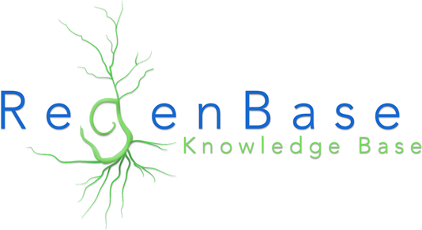RegenBase Data Sets
RegenBase includes manually curated metadata and results from published papers, as well as several published assay data sets:
All of the above assays measure kinase activity in the presence of a perturbagen at a specified concentration with respect to a control. Only wild-type kinase assays were included. The KINOMEscan data consists of dissociation constant (Kd) values for compound-kinase pairs, which we transformed to pKd values by first converting the nanomolar Kd values to molar values, and then calculating the -log10 of each molar Kd value. The NanoSyn and RBC assay data consist of % inhibition values for compound-kinase pairs. The KIBA dataset quantifies the effect of a given perturbagen on a kinase. KIBA values are originally reported as the base-10 logarithm of adjusted Ki (nM) values, and were transformed to adjusted pKi values according to the equation: -(x-9), where x = KIBA value.
RegenBase also includes several gene expression data sets:
If you have large data sets relevant to spinal cord injury and axon regeneration that you would like to add to the knowledge base, please contact us.
- hippocampal neurite outgrowth assays, profiling the effect of 1606 compounds on neurite outgrowth
- an analysis of kinase inhibitor selectivity measured using DiscoverRx’s KINOMEscan, profiling the effect of 72 compounds on 442 kinases
- the GSK Published Kinase Inhibitor Set (PKIS) measured using NanoSyn’s fluorescence assay, profiling the effect of 367 compounds on 199 kinases
- an assay of kinase catalytic activity measured using Reaction Biology Corporation’s (RBC) radiometric assa,y profiling the effect of 178 compounds on 300 kinases
- the Kinase Inhibitor BioActivity (KIBA) value, profiling the effect of 51,961 compounds on 467 kinases
All of the above assays measure kinase activity in the presence of a perturbagen at a specified concentration with respect to a control. Only wild-type kinase assays were included. The KINOMEscan data consists of dissociation constant (Kd) values for compound-kinase pairs, which we transformed to pKd values by first converting the nanomolar Kd values to molar values, and then calculating the -log10 of each molar Kd value. The NanoSyn and RBC assay data consist of % inhibition values for compound-kinase pairs. The KIBA dataset quantifies the effect of a given perturbagen on a kinase. KIBA values are originally reported as the base-10 logarithm of adjusted Ki (nM) values, and were transformed to adjusted pKi values according to the equation: -(x-9), where x = KIBA value.
- the data from a knock-down screen of phosphatases, (219 phosphatases knocked down using 1086 shRNA clones (TRC1 shRNA library;Sigma Aldrich). The data was kindly provided by Cafferty & Strittmatter.
RegenBase also includes several gene expression data sets:
- Gene expression data generated by RNA-Sequencing measuring the response of mouse dorsal root ganglion neurons to either a sciatic nerve crush or sham surgery seven days post surgery
- Gene expression data generated by microarray measuring the response of rat dorsal root ganglion neurons to either a sciatic nerve crush or dorsal root crush surgery 12, 24, 72 hours or 7 days post surgery
- Gene expression data generated by microarray measuring the response of rat dorsal root ganglion neurons to either a proximal sciatic nerve crush, distal sciatic nerve crush, or sham surgery 1, 3, 8, 12, 18, 24, and 28 hours post surgery
If you have large data sets relevant to spinal cord injury and axon regeneration that you would like to add to the knowledge base, please contact us.
